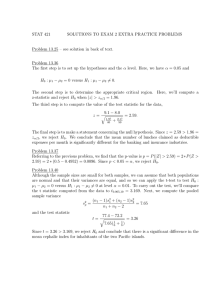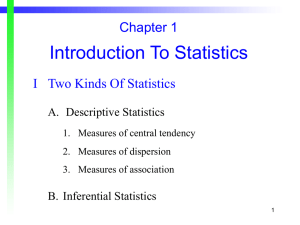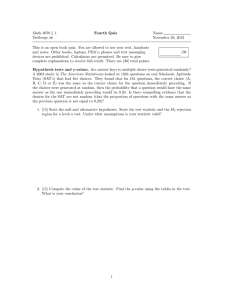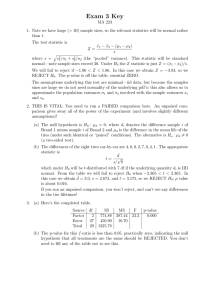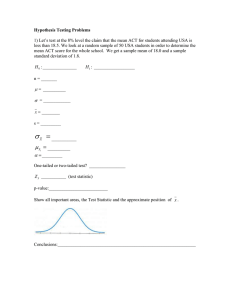Statistics Exam Questions: Hypothesis Testing & Confidence Intervals
advertisement
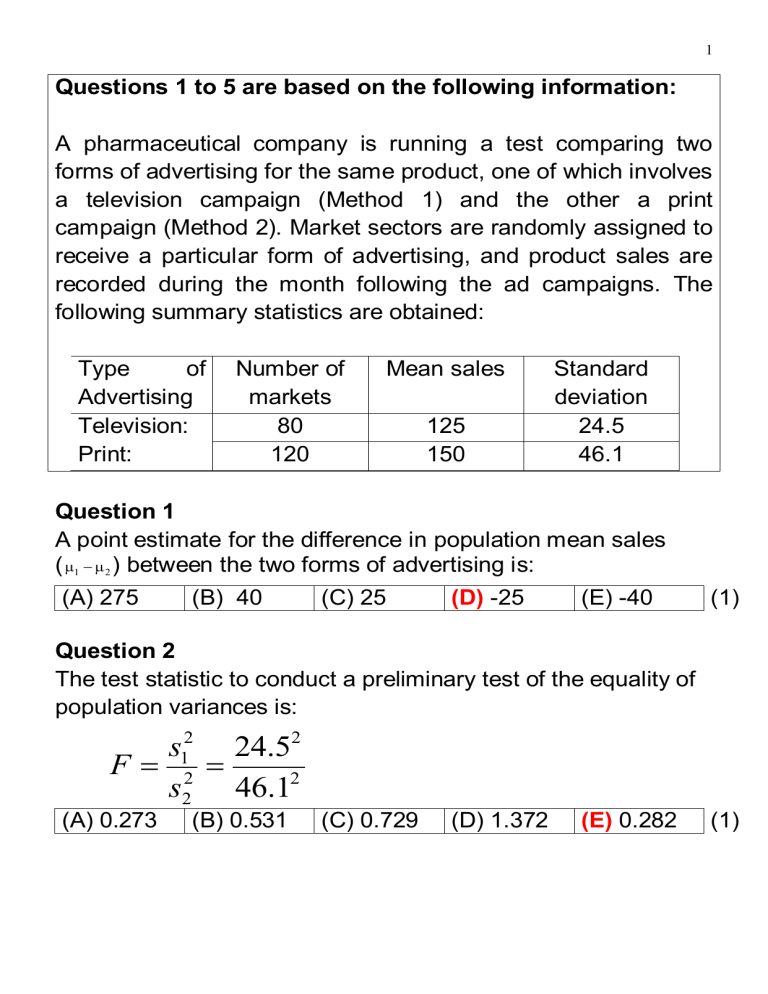
1 Questions 1 to 5 are based on the following information: A pharmaceutical company is running a test comparing two forms of advertising for the same product, one of which involves a television campaign (Method 1) and the other a print campaign (Method 2). Market sectors are randomly assigned to receive a particular form of advertising, and product sales are recorded during the month following the ad campaigns. The following summary statistics are obtained: Type of Advertising Television: Print: Number of markets 80 120 Mean sales 125 150 Standard deviation 24.5 46.1 Question 1 A point estimate for the difference in population mean sales ( 1 2 ) between the two forms of advertising is: (A) 275 (B) 40 (C) 25 (D) -25 (E) -40 (1) Question 2 The test statistic to conduct a preliminary test of the equality of population variances is: s12 24.52 F 2 s2 46.12 (A) 0.273 (B) 0.531 (C) 0.729 (D) 1.372 (E) 0.282 (1) 2 Question 3 2 2 Given the critical values to test H 0 : 1 2 versus H1 : 12 22 are F0.975,(79,119) 1.45 and F0.0255,(79,119) 0.658 , your conclusion is We reject H and conclude that there is no significant (A) evidence to show that 12 22 . 0 We do not reject H and conclude that there is no significant evidence to show that 12 22 . 0 (B) H 0 and conclude that there is significant (C) We reject 2 2 evidence to show that 1 2 . We do not reject H and conclude that there is significant (D) evidence to show that 12 22 . 0 (E) Cannot yet make a decision. (2) Question 4 The test statistic, to test if there is a significant difference in product sales by method of advertisement is: Z X 1 X2 0 s12 s22 n1 n2 (A) -4.979 125 150 24.52 46.12 80 120 (B) -1.960 (C) 36.232 (D) 30.087 (E) -1.001 (2) 3 Question 5 A 95% confidence interval estimate for the difference in the mean product sales between method 1 and method 2 is: (A) 25 (1.645) 24.5 46.1 (24.5)2 (46.1)2 (B) 25 (1.645) 80 120 80 (C) (E) 25 (1.645) (24.5)2 (46.1)2 80 120 2 24.5 46.1 25 (1.96) 80 120 (D) 25 (1.96) 120 (24.5)2 (46.1)2 80 120 2 (1) Questions 6 to 9 are based on the following information: An entomologist conducted an experiment to see if wounding a tomato plant would induce changes that improve its defence against insect attack. She grew larvae of the tobacco hornworm on wounded plants and control plants. The accompanying table shows the weight (mg) of the larvae after 7 days of growth. Assume that the data are normally distributed and the two population variances are equal. Control (Group 1) n: X: Standard deviation (S): 18 37.96 11.14 Wounded (Group 2 16 28.66 9.02 Note: Better defence implies less larvae Question 6 The pooled estimate of the common standard deviation is: Sp (n1 1) s12 (n2 1) s22 (17)11.14 2 (15)9.02 2 n1 n2 2 32 (A) 102.73 (B) 11.979 (C) 10.201 (D) 104.066 (E) 103.987 (2) 4 Question 7 The null and alternative hypothesis for this experiment is: (A)H 0 : X1 X 2 (B)H 0 : 1 2 (C)H 0 : 1 2 (D)H 0 : 1 2 (E)H 0 : X1 X 2 H 1 : X1 X 2 H 1 : 1 2 H 1 : 1 2 H 1 : 1 2 H 1 : X1 X 2 (1) Question 8 The value of the test statistic is: t X 1 Sp (A) 0.912 X 2 0 1 1 n1 n2 (B) 2.653 37.96 28.66 0 10.201 (C) 2.037 1 1 18 16 (D) 0.757 (E) None of A - (2) D Question 9 Assume the calculated test statistic was 2.32. The p-value that you are going to report in your research article is: (A) 0.9706 (B) (C) (D) 0.02<p(E) 0.01<p(2) 0.0294 0.0588 value<0.05 value<0.025 5 Questions 10 to 11 are based on the following information: A pharmaceutical company claims that a new formula it has prepared could improve the growth of malnourished babies, more than a generic brand. The weight gains of 14 babies in the month before they were given the new formula (Before) and the month after they were given the new formula (After) were recorded and given in the following table Babies 1 2 3 4 5 6 7 8 9 10 11 12 13 14 Before 175 132 218 151 200 219 234 199 236 248 206 179 214 249 After 142 211 337 262 302 195 253 149 187 211 176 214 206 179 Differences -33 79 119 111 102 -24 19 -50 -49 -37 -30 35 -8 -70 ( di ) The summary statistics on the difference scores ( d i ) are 14 d i 164 i 1 sd 65.978 Assume that the difference scores ( d i ) are normally distributed. Question 10 The null and alternative hypotheses to test if there is any improvement in the babies’ growth because of the use of the new formula are: (A) H0 : d 0 vs. H1 : d 0 (B) H 0 : d 0 vs. H1 : d 0 (C) (E) H 0 : d 0 vs. H1 : d 0 (D) H 0 : d 0 vs. H1 : d 0 H 0 : d 0 vs. H1 : d 0 (1) Question 11 The value of the calculated test statistic is: X d 0 164 / 14 0 t d sd 65.978 14 n (A) 0.177 (B) 0.664 (C) 1.506 (D) 2.160 (E) 1.96 (2) 6 Questions 12 We wish to design a study to compare two antihypertensive medications. Two outcome variables will be considered: systolic and diastolic blood pressure. How many subjects would be required to detect with 80% power and 5% level of significance a difference of 10 units in mean systolic blood pressures between two groups? Assume that the standard deviation in systolic blood pressure is 25. 1 2 10 ES 0.4 25 Z1 Z1 2 ni 2 ES 1.96 0.84 2 0 . 4 (A) 25 subjects per group (B) 69 subjects per group (C) 98 subjects per group (D) 50 subjects per group 2 2 (E) 138 subjects per group (2) Questions 13 to 17 are based on the following information: A study is conducted to determine if the percent of women who receive financial aid in undergraduate study is different from the percent of men who receive financial aid in undergraduate study. A random sample of undergraduates revealed the following results: Sample size: Number receiving aid: Women Men (Group 1) (Group 2) 250 300 200 180 7 Question 13 A point estimate for the difference in proportions of women and men who received financial aid is: 200 180 pˆ 1 pˆ 2 0.8 0.6 0.2 250 300 (A) 0.20 (B) 0.6 (C) 0.69 (D) 0.80 (E) None of these (1) Question 14 The standard error of the point estimate of the difference in proportions is: pˆ 1 (1 pˆ 1 ) pˆ 2 (1 pˆ 2 ) 0.8 * 0.2 0.6 * 0.4 n1 n2 250 300 (A) 0.0023 (B) 0.0014 (C) 0.0365 (D) 0.0379 (E) None of these (2) Question 15 The test statistic value to conduct a test on H 0 : p1 p2 versus H1 : p1 p2 is z ( pˆ 1 pˆ 2 ) 1 1 pˆ (1 pˆ ) n1 n2 (A) 1.96 (B) 5.051 0.8 0.6 1 1 0.691(1 0.691) 250 300 pˆ (C) 6.542 (D) X1 X 2 n1 n2 200180 250 300 0.691 (E) 1.96 or 1.96 1.645 or 1.645 Question 16 A 95% confidence interval for the difference in the proportions of women and men who received financial aid is: (A) 1 1 0.69 (1.645) (0.69)(0.31) 250 300 (B) 1 1 0.20 (1.96) (0.69)(0.31) 250 300 (2) 8 (C) 1 1 0.69 (1.96) (0.69)(0.31) 250 300 (E) 0.20 (1.645) (D) 0.20 (1.96) 0.80(0.20) 0.60(0.40) 250 300 0.80(0.20) 0.60(0.40) 250 300 (1) Question 17 The critical or rejection region of the test in Question 15 at 5% level of significance is: (A) (B) (C) (D) (E) (1 1.645 or 1.645 ) 1.96 Z 1.96 1.96 1.96 1.96 or 1.96 Questions 18 to 20 are based on the following information: A public health researcher believes that smoking affects the gender of offspring. He records the gender of newborns that are delivered in local hospitals over a one-year period. He also interviews the parents of the newborns to determine their degree of cigarette smoking. The following data are collected. Offspring Cigarette Smoking Boys Girls Total Neither parent smokes at 60 40 100 least a pack a day One parent smokes at least 57 43 100 a pack a day Both parents smoke at least 18 32 50 a pack a day Total 135 115 250 9 The null and alternative hypotheses for the research are H0 : There is no association between Cigarette smoking and gender of offspring versus H1 : There is association between Cigarette smoking and gender of offspring. Question 18 The expected frequency of “One parent smokes at least a pack a day” and the offspring are girls ( E22 ) under the null hypothesis is: (A) 17.20 (B) 19.78 (C) 43 (D) 46 (E) 54 (1) Question 19 The degrees of freedom for the (A) 6 (B) 5 (C) 4 2- test statistic is: (D) 3 (E) 2 (1) Question 20 The critical or rejection region of the test at 1% level of significance is: (A) 5.99 (B) 9.21 (C) 10.60 (D) 11.34 (E) 16.81 (2) Questions 21 to 28 are based on the following information: In order to test the yielding abilities of five different wheat varieties, 20 equal-sized plots were allocated to a uniform site. Each variety was planted in four plots, the distribution of the varieties being random. The yields of grain in kg/plot were measured, summary of the results were as follows: Variety : 1 2 3 4 5 Mean (kg/plot) : 26.50 21.50 25.75 18.75 22.50 10 Variance ( si2 ) : 4.33 1.67 4.92 2.92 7.00 Assume that wheat yield is normally distributed and the population variances of the five wheat varieties are equal. The following partially completed analysis of variance table is computed using the above summary statistics: Source of Sum of Degrees of Mean variation squares freedom squares F Between 161.5 ? ? ? variety ? ? ? Within variety Total 224.0 Question 21 Using the summary statistic from the above table, the overall mean yield (i.e. X.. ) is: (A) 28.75 (B) 23 (C) 5.75 (D) 115 (E) 92 (2) Question 22 The within variety sum squares (i.e. SS w ) is: (A) 4.167 (B) 15.000 (C) 40.375 (D) 62.500 (E) 161.5 (1) Question 23 The between variety mean squares (i.e. S b2 ) is: (A) 32.5 (B) 40.375 (C) 10.767 (D) 4.167 (2) (E) 161.5 11 Question 24 The F – test statistic value to test the hypotheses H 0 : 1 2 3 4 5 H 1 : Means not all equal. (A) 0.103 (B) 2.584 , is: (C) 3.06 (D) 9.689 (E) 3.80 (2) Question 25 The numerator and denominator degrees of freedom for the Fstatistic value in Question 24 are: (A) 4 and 19 (B) 4 and 15 (C) 5 and 15 (D) 5 and 19 (E) 4 and 16 (1) Question 26 An appropriate conclusion to the test the hypotheses in Question 24 given that the p-value < 0.001 is: A B C D E There is significant evidence, at 0.01 , to show that the mean wheat yields under the five wheat varieties are all equal. There is insufficient evidence to indicate that there is difference in the mean wheat yields among the five wheat varieties at 5% level of significance. There is significant evidence, at 0.01 , to show that the mean wheat yields under the five wheat varieties are not all equal. There is no sufficient evidence to make comparison on the mean yields among the five wheat varieties. None of the above. (2) 12 Question 27 The test statistic value to conduct the Scheffe pairwise comparisons between the mean yields of varieties 1 and 4 is: F (X i X j )2 1 1 s n n j i 2 W ( X .i X . j ) 2 1 1 MS error n n j i (A) 28.828 (B) 14.414 (C) 5.371 (D) 3.720 (E) 2.975 (2) Question 28 The decision rule to conduct the test H 0 : 1 3 H 1 : 1 3 using the Scheffe pairwise comparisons at 5% level of significance is: (A) Reject (B) Reject H0 H0 F 3.06 F 15.3 (C) Reject H0 F 12.24 (D) Reject H0 F 11.6 (E) Reject H0 F 2.90 (2) 13 Questions 29 to 33 are based on the following information: A researcher interested in the relationship between the rate of germination of warm-season forage grasses and temperature has postulated a linear regression model in which the number of seeds germinated per day is dependent (Y) on the average daily temperature (X). The following data were collected by the researcher. Temperature Germinated Temperature Germinated (0C) Seed (0C) Seed (X) (number / (X) (number / day) day) 10 5 22 28 11 7 23 31 13 9 24 35 15 10 26 38 16 14 27 49 18 20 29 55 20 24 30 61 21 25 32 73 The following summary statistics obtained from the above data: n 16 , X 16 i 1 X 696.94, 2 i 16 16 i 1 i 1 X i 337 , Y 16 i 1 X 16 i 1 i i Y 6301.00, 2 X Yi Y 2029.75 Yi 484 , 14 80 y = 2.9124x - 31.092 R² = 0.9382 70 60 50 40 30 20 10 0 0 5 10 15 20 25 30 35 -10 Question 29 An estimate of the slope of the linear-regression line relating the number of seeds germinated per day to the average daily temperature is: (A) (B) 0.322 (C) 0.969 (D) 2.912 (E) None of the (2) 31.092 previous Question 30 An estimate of the the Y-intercept of the linear-regression line relating the number of seeds germinated per day to the average daily temperature is: (A) -31.092 (B) (C) 0.969 (D) 2.912 (E) None of the (2) 0.322 previous Question 31 The sample correlation coefficient (r) between the number of seeds germinated per day and the average daily temperature is: (A) (B) 0.938 (C) 0.969 (D) 0.322 (E) None of the 0.969 previous (2) 15 Question 32 The test statistic to test the hypotheses , is: (A) 3.744 (B) 14.561 (C) (D) 15.566 20.592 versus (E) None of the previous (1) Question 33 The percent of variation in the number of seeds germinated per day explained by the average daily temperature, is: (A) (B) (C) (D) (E) None of the (1) 93.896% 96.900% 2.912% 87.980% previous Questions 34 and 35 are based on the following information: In an investigation of possible brain damage due to alcoholism, an X-ray procedure known as a computerized tomography (CT) scan was used to measure brain densities in eleven chronic alcoholics. For each alcoholic, a non-alcoholic control was selected who matched the alcoholic on age, sex education and other factors. The brain density measurements on the alcoholics and the matched controls are reported in the following table. Pair Alcoholic Control Differences ( di ) 1 2 3 4 5 6 7 8 9 10 11 40.1 38.5 36.9 41.4 40.6 42.3 37.2 38.6 38.5 38.4 38.1 41.3 40.2 37.4 46.1 43.9 41.9 39.9 40.4 38.6 38.1 39.5 -1.2 -1.7 -0.5 -4.7 -3.3 0.4 -2.7 -1.8 -0.1 0.3 -1.4 Assume that the distribution of the differences are skew (not normally distributed). 16 Question 34 The null and alternative hypothesis for this investigation is: (A) H 0 : 1 2 versus H 1 : 1 2 (B) H 0 : 1 2 versus H 1 : 1 2 (C) H 0 : Medians are equal, versus H 1 : Medians are not equal. (D) H 0 : The medians are equal, versus H 1 : The median brain density of the alcoholic group is less than that of Control group. (E) H 0 : The medians are equal, versus H 1 : The median brain density of the alcoholic group is greater than that of Control group. (1) Question 35 The Wilcoxon signed-rank test, test statistic value using the normal approximation is: Z n(n 1) 4 n(n 1)(2n 1) 24 (A) -5.824 T (B) -1.022 (C) -0.482 (D) 1.022 (E) -2.490 (2) END OF PAPER 17
